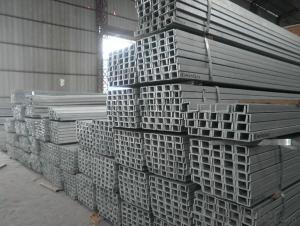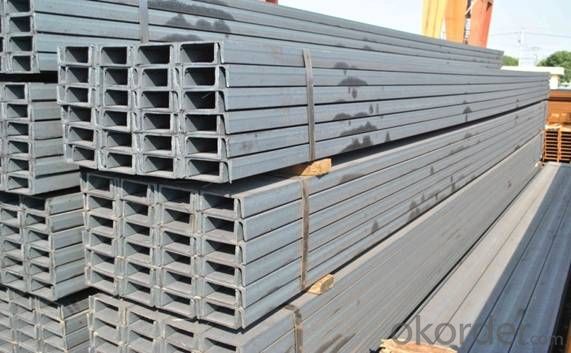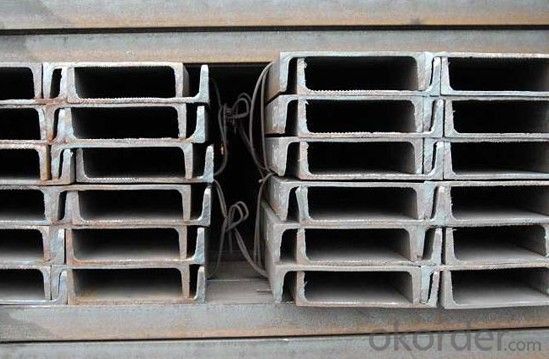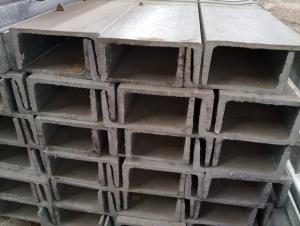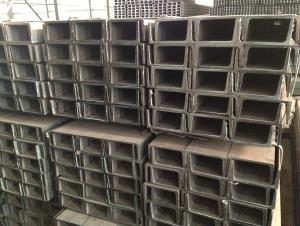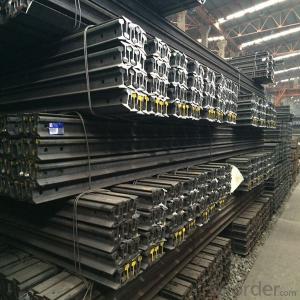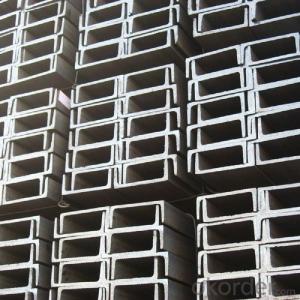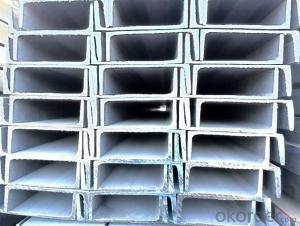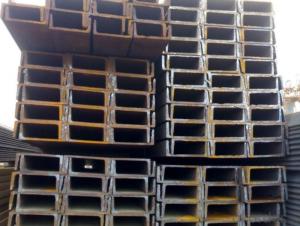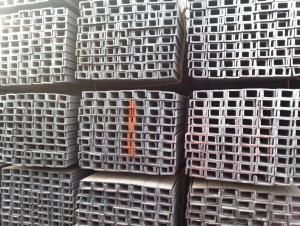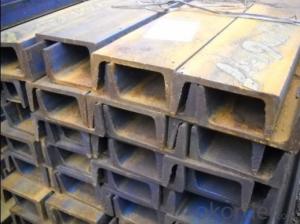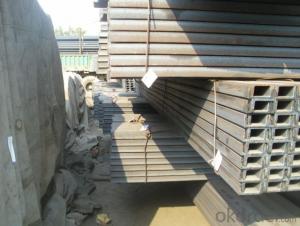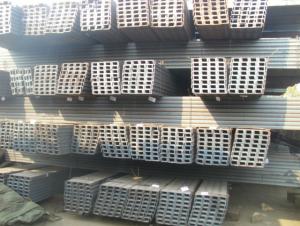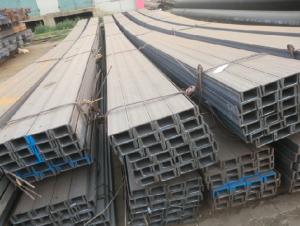50mm JIS Standard U Channels for construction
- Loading Port:
- Tianjin
- Payment Terms:
- TT OR LC
- Min Order Qty:
- 25 m.t.
- Supply Capability:
- 10000 m.t./month
OKorder Service Pledge
OKorder Financial Service
You Might Also Like
Product Applications:
Japanese Standard U-channels are ideal for structural applications and are widely used in the construction of buildings and bridges, and the manufacturing, petrochemical, and transportation industries.
Product Advantages:
OKorder's Japanese Standard U-channels are durable, strong, and resist corrosion.
Main Product Features:
· Premium quality
· Prompt delivery & seaworthy packing (30 days after receiving deposit)
· Corrosion resistance
· Can be recycled and reused
· Mill test certification
· Professional Service
· Competitive pricing
Product Specifications:
Manufacture: Hot rolled
Grade: Q195 – 235
Certificates: ISO, SGS, BV, CIQ
Length: 6m – 12m, as per customer request
Packaging: Export packing, nude packing, bundled
Product Applications:
Japanese Standard U-channels are ideal for structural applications and are widely used in the construction of buildings and bridges, and the manufacturing, petrochemical, and transportation industries.
Product Advantages:
OKorder's Japanese Standard U-channels are durable, strong, and resist corrosion.
Main Product Features:
· Premium quality
· Prompt delivery & seaworthy packing (30 days after receiving deposit)
· Corrosion resistance
· Can be recycled and reused
· Mill test certification
· Professional Service
· Competitive pricing
Product Specifications:
Manufacture: Hot rolled
Grade: Q195 – 235
Certificates: ISO, SGS, BV, CIQ
Length: 6m – 12m, as per customer request
Packaging: Export packing, nude packing, bundled
Quick Details
Place of Origin:Hebei, China (Mainland)
Material:Steel
technique:hot rolled
Standard:AISI,ASTM,BS,DIN,GB,JIS
thickness:3-9mm, 6-13mm
Application:Building construction
Width:50mm-300mm
Length:6m-12m or as your request
Shape:U shape
Material:Q235, SS400 etc
Normal Length:12m/6m
Packaging & Delivery
| Packaging Details: | according to the customer's request |
|---|---|
| Delivery Detail: | about 25-30 days after receive your payment |
Specifications
channel steel
1)Size: 51x25x3mm-305x80x13mm
2)Material: Q195,Q215,Q235,A36,SS400,SS540
3)Packing:bundle with strips
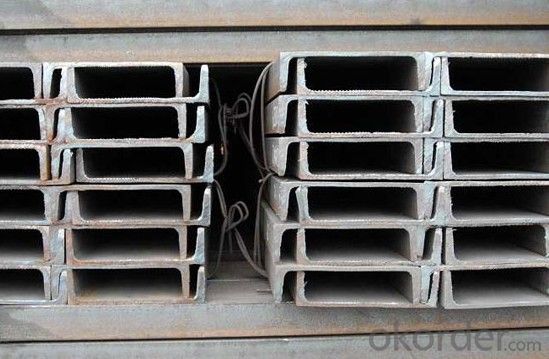
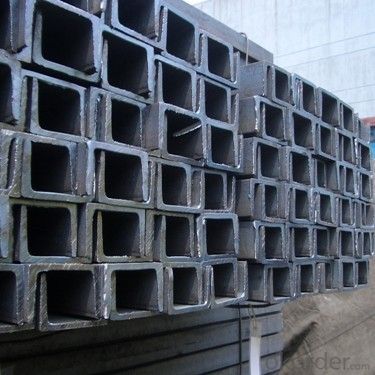
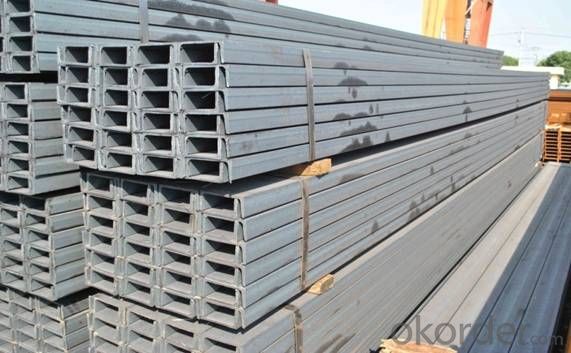
- Q: What are the common accessories used with steel channels?
- Some common accessories used with steel channels include brackets, fasteners (such as bolts, screws, and rivets), connectors, clips, and end caps. These accessories are used to secure and connect steel channels to other structural elements, provide additional support, and enhance the overall functionality and stability of the channel system.
- Q: Can steel channels be used for curtain wall systems?
- Curtain wall systems can utilize steel channels, which serve as the framing system and provide structural support for the attachment of glass panels or cladding materials. These systems are typically made of lightweight materials like aluminum or steel, creating a non-structural exterior wall system that protects against weather conditions. Steel channels offer numerous advantages, including their high strength-to-weight ratio, durability, and ability to be prefabricated off-site for efficient installation. Nonetheless, it is crucial to consider the specific design requirements and load calculations to ensure the steel channels meet the necessary structural and performance criteria for curtain wall systems.
- Q: Can steel channels be galvanized or coated?
- Yes, steel channels can be galvanized or coated. Galvanizing is a process where a layer of zinc is applied to the surface of the steel channel to protect it from corrosion. This process involves dipping the steel channel into a bath of molten zinc or by applying a zinc coating using other methods such as electroplating or spraying. The zinc coating provides a barrier between the steel and the surrounding environment, preventing the steel from rusting. Coating steel channels is another option to protect them from corrosion. There are various types of coatings available, such as epoxy, polyurethane, or powder coatings, which can be applied to the surface of the steel channel. These coatings create a protective layer that shields the steel from moisture, chemicals, and other corrosive elements. Both galvanizing and coating steel channels enhance their durability and extend their lifespan. The choice between galvanizing and coating depends on factors such as the intended application, the environmental conditions in which the steel channel will be used, and the desired aesthetic appearance.
- Q: Can steel channels be used in curved designs?
- Indeed, curved designs can incorporate steel channels. These flexible structural elements can conform to a multitude of curves and contours, making them highly versatile. With the aid of specialized machinery and techniques like hot or cold bending, steel channels can be expertly shaped or bent. Consequently, this enables the fabrication of bespoke curved designs utilizing steel channels. The resultant curved steel channels not only enhance the structure's robustness, stability, and endurance, but they also contribute to the overall visual allure of the design.
- Q: How do steel channels contribute to thermal insulation?
- Thermal insulation is not achieved solely by steel channels. Rather, steel channels serve as structural components in construction, commonly used in the framing of walls or ceilings. However, in relation to thermal insulation, steel channels can be utilized as part of a system to enhance overall insulation performance. To incorporate steel channels into thermal insulation systems, one can construct a framework or support structure for insulating materials like foam boards or mineral wool. These materials are then placed within the steel channels, establishing a barrier that aids in reducing heat transfer. By supplying a stable and secure framework, steel channels ensure the proper installation and maintenance of insulation materials. This eliminates any gaps or air pockets that may compromise insulation effectiveness. Moreover, steel channels have the capacity to create air cavities or gaps within the insulation system. These air pockets act as additional barriers to heat transfer since air is a poor conductor of heat. By minimizing direct contact between interior and exterior surfaces, steel channels contribute to the overall thermal insulation of the structure. It is crucial to recognize that while steel channels can play a role in thermal insulation, they alone are insufficient for effective insulation. They must be used in conjunction with suitable insulating materials and other insulation techniques, such as gap sealing and the use of reflective surfaces, to achieve optimal thermal insulation performance.
- Q: What are the different methods for protecting steel channels from UV radiation?
- There are several methods available for protecting steel channels from UV radiation. 1. Paint: One of the most common methods is to apply a UV-resistant paint coating on the surface of the steel channels. These paints contain special additives that help to reflect or absorb UV radiation, preventing it from reaching the steel and causing degradation. 2. Powder coating: Powder coating is another effective method for protecting steel channels from UV radiation. In this process, a dry powder is applied electrostatically to the surface of the steel, and then heated to form a protective coating. Powder coatings are available in a variety of colors and finishes, and many of them offer excellent UV resistance. 3. Galvanization: Galvanizing steel channels is a popular method for protecting them from UV radiation as well as other forms of corrosion. In this process, the steel is coated with a layer of zinc, which acts as a sacrificial barrier against UV rays and other environmental factors. This helps to extend the lifespan of the steel channels significantly. 4. UV-resistant coatings: There are specialized UV-resistant coatings available in the market specifically designed for protecting steel from UV radiation. These coatings are typically applied as a liquid and form a thin, transparent layer on the surface of the steel. They provide excellent UV protection while maintaining the appearance of the steel channels. 5. Protective films: Another method for protecting steel channels from UV radiation is by using protective films or tapes. These films are applied directly to the surface of the steel and act as a barrier against UV rays. They are easy to install and remove, making them a cost-effective solution for temporary protection. It is important to choose the most appropriate method based on the specific application and requirements. Factors such as the level of UV exposure, desired lifespan, and aesthetic considerations should be taken into account when selecting a method for protecting steel channels from UV radiation.
- Q: What are the common surface finishes available for steel channels?
- Steel channels have several options for surface finishes. These finishes serve to enhance their appearance, protect against corrosion, and improve durability. One popular surface finish is a plain or mill finish. This finish involves leaving the steel channels in their natural state after manufacturing. It results in a smooth, slightly reflective surface, but does not offer additional corrosion protection. Another common surface finish is hot-dip galvanizing. This process entails immersing the steel channels in molten zinc, creating a protective coating. Hot-dip galvanized steel channels appear dull gray and provide excellent corrosion resistance, making them ideal for outdoor or high-moisture environments. Powder coating is also favored for steel channels. It involves applying a dry powder electrostatically and then curing it with heat. Powder-coated steel channels have a smooth, durable finish and are available in many colors. This finish offers good corrosion resistance and is commonly used indoors. Furthermore, steel channels can be painted using various paint finishes applied by spray, roller, or brush. Painted steel channels provide aesthetic appeal and can be customized to match specific color requirements. They also offer some corrosion protection, with the level varying based on paint quality and application process. In summary, common surface finishes for steel channels include plain or mill finish, hot-dip galvanizing, powder coating, and paint finishes. Each finish offers distinct advantages in terms of appearance, corrosion resistance, and durability. The choice of surface finish depends on the application's specific requirements and desired outcome.
- Q: Channel 18, number 18. What does it mean?
- The theoretical weight of 19.752 kg per metre, channel 18#a specifications 180X, 68x 7 mm, theoretical weight of 20.174 kg per meter, channel 18#b specifications 180 X70 x9mm, theoretical weight of 23 kg per meter, specifications are x height, X leg width, waist thickness.
- Q: Are steel channels suitable for load-bearing walls?
- Typically, steel channels are not suitable for load-bearing walls. These walls are designed to bear the weight of a building or other structural elements, so they require materials that possess high compressive strength and stability. Steel channels, also referred to as C-channels or U-channels, are commonly utilized for non-structural purposes such as framing and supporting secondary components like cladding or drywall. They lack the necessary structural properties to withstand heavy loads and may not provide the required stability and rigidity. Load-bearing walls are typically constructed using materials like concrete, masonry, or steel beams that are specifically engineered to handle the forces involved in supporting a structure.
- Q: What are the different types of connections used with steel channels?
- There are several types of connections that can be used with steel channels, depending on the specific application and structural requirements. Some of the commonly used connections include: 1. Welded connections: Welding is a popular method for connecting steel channels. It involves joining the channels by melting the adjacent edges and allowing them to solidify, creating a strong and durable connection. Welded connections can be full penetration, where the entire thickness of the channel is welded, or partial penetration, where only a portion of the thickness is welded. 2. Bolted connections: Bolted connections involve using bolts and nuts to connect steel channels. Holes are drilled in the channels, and bolts are inserted through these holes, with nuts tightened to hold the channels together. Bolted connections offer flexibility and ease of assembly and disassembly, making them suitable for situations where frequent maintenance or modifications are required. 3. Mechanical connections: Mechanical connections utilize specialized connectors, such as couplings, brackets, or plates, to join steel channels. These connectors are designed to provide a secure and reliable connection without the need for welding or bolting. Mechanical connections are often used in applications where quick installation or alignment adjustments are necessary. 4. Riveted connections: Riveting involves using rivets, which are metal pins with a formed head on one end, to connect steel channels. The rivets are inserted through pre-drilled holes in the channels and then hammered or riveted into place, securing the connection. Riveted connections were widely used in the past but have become less common due to the availability of more efficient connection methods. 5. Adhesive connections: Adhesive connections involve using high-strength adhesives to bond steel channels together. The adhesive is applied to the contact surfaces of the channels, and pressure is applied to ensure a strong bond. Adhesive connections are useful in situations where welding or bolting is not feasible, such as joining dissimilar metals or materials with high thermal expansion coefficients. Each type of connection has its advantages and limitations, and the choice depends on factors such as load requirements, design considerations, and project specifications. It is essential to consult with a structural engineer or professional fabricator to determine the most appropriate type of connection for a given steel channel application.
Send your message to us
50mm JIS Standard U Channels for construction
- Loading Port:
- Tianjin
- Payment Terms:
- TT OR LC
- Min Order Qty:
- 25 m.t.
- Supply Capability:
- 10000 m.t./month
OKorder Service Pledge
OKorder Financial Service
Similar products
Hot products
Hot Searches
Related keywords
